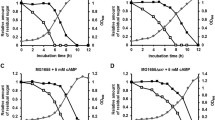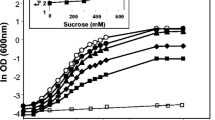Abstract
The effects of mannitol were investigated by comparing some metabolic features in colonial derivatives, I-110 and L1-110, ofRhizobium japonicum strain 3IIb110, grown either on glucose alone (G-cells) or in glucose media supplemented with mannitol (GM-cells). The polyol stimulated the synthesis of not only mannitol dehydrogenase, which is active in derivative L1-110, but also the nicotinamide adenine dinucleotide (NAD)-linked 6-phosphogluconate (6-PG) dehydrogenase (EC 1.1.1.43). As revealed by radiorespirometry, when GM-cells were allowed to metabolize glucose, they produced relatively more CO2 from the first and sixth carbons of the sugar than G-cells did. This finding is evidence that NAD-linked 6-PG dehydrogenase might initiate an unknown pathway different from the hexose cycle and the pentose phosphate (PP) pathway. Mannitol exerted no allosteric control on the oxygen consumption and the glucose transport systems. Active uptake of the polyol was correlated with the presence of mannitol dehydrogenase (EC 1.1.1.67); it did not hinder the transport of glucose even though both systems derive their energy for active transport from a common source presumptively characterized as the energized membrane state. Mannitol, however, suppressed by two- or threefold the glucose uptake system. Addition of the polyol to the cell suspensions of both colonial types ofR. japonicum metabolizing glucose caused an immediate 40–50% drop of adenosine triphosphate (ATP) concentrations, owing in part to the mannitol kinase reaction. Type I-110 failed to overcome this reduction of ATP levels, and low growth rates could results. In contrast, type L1-110 offsets the reduction of ATP concentration by oxidizing mannitol as an additional source of energy through mannitol dehydrogenase, fructokinase, and a sequence of glycolytic reactions. The polyol also induced type L1-110 to produce extracellular slimy materials that, apparently, harbor amounts of ATP and proteins.
Similar content being viewed by others
Literature Cited
Doelle, H. W. 1969. Chemosynthesis, Pathways of carbohydrate breakdown, pp. 129–198. In: Doelle, H. W. (ed.), Bacterial metabolism, New York, London: Academic Press.
Hollmann, S. 1964. Metabolism ofd-gluconic acid, pp. 17–21. In: Hollman, S. (ed.), Non-glycolitic pathways of metabolism of glucose. New York, London: Academic Press.
Kuykendall, L. D., Elkan, G. H. 1977. Some features of mannitol metabolism inRhizobium japonicum. Journal of General Microbiology98:291–295.
Larson, R. J., Pate, J. L. 1976. Glucose transport in isolated prosthecae ofAsticcacaulis biprosthecum. Journal of Bacteriology126:282–293.
Lengeler, J. 1975. Mutations affecting transport of the hexitolsd-mannitol,d-glucitol, and galactitol inEscherichia coli K-12: Isolation and mapping. Journal of Bacteriology124:26–38.
Lieberman, M. A., Hong, J. S. 1976. Changes in active transport, intracellular adenosine 5′-triphosphate levels, macromolecular syntheses, and glycolysis in an energy-uncoupled mutant ofEscherichia coli. Journal of Bacteriology125:1024–1031.
Martinez-de Drets, G., Arias, A. 1970. Metabolism of some polyols byRhizobium meliloti. Journal of Bacteriology103:97–103.
Maryanski, J. H., Wittenberger, C. L. 1975. Mannitol transport inStreptococcus mutants. Journal of Bacteriology124:1475–1481.
Mortenson, L. E., Hamilton, P. B., Wilson, P. W. 1955. Dissimilation of 6-phosphogluconate byAzotobacter vinelandii. Biochimica et Biophysica Acta16:238–244.
Mulongoy, K., Elkan, G. H. 1977. Glucose catabolism in two derivatives of aRhizobium japonicum strain differing in nitrogen-fixing efficiency. Journal of Bacteriology131:179–187.
Schneider, R. P., Wiley, W. R. 1971. Kinetic characteristics of the two glucose transport systems inNeurospora crassa. Journal of Bacteriology131:479–486.
Schram, E. 1970. Use of scintillation counters for bioluminescence assay of adenosine triphosphate (ATP), pp. 129–133. In: Bransome, E. D., Jr. (ed.), The current status of liquid scintillation counting. New York: Grune and Stratton.
Sperry, J. F., Robertson, D. C. 1975. Inhibition of growth by erythritol catabolism inBrucella abortas. Journal of Bacteriology124:391–397.
Tanaka, S., Lerner, S. A., Lin, E. C. C. 1967. Replacement of a phosphoenolpyruvate-dependent phosphotransferase by a nicotinamide adenine dinucleotide-linked dehydrogenase for the utilization of mannitol. Journal of Bacteriology93:642–648.
Author information
Authors and Affiliations
Rights and permissions
About this article
Cite this article
Mulongoy, K., Elkan, G.H. Some effects of mannitol on the glucose metabolism of two derivatives of a strain ofRhizobium japonicum differing in mannitol dehydrogenase. Current Microbiology 1, 335–340 (1978). https://doi.org/10.1007/BF02621365
Issue Date:
DOI: https://doi.org/10.1007/BF02621365




